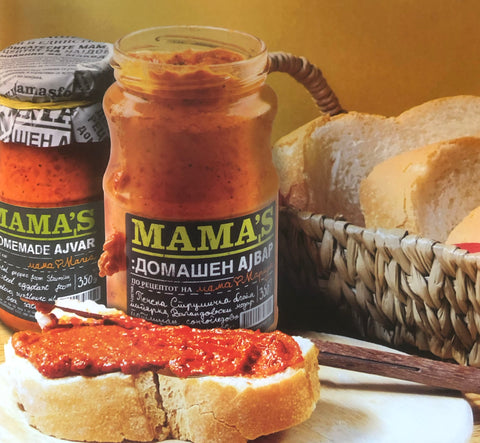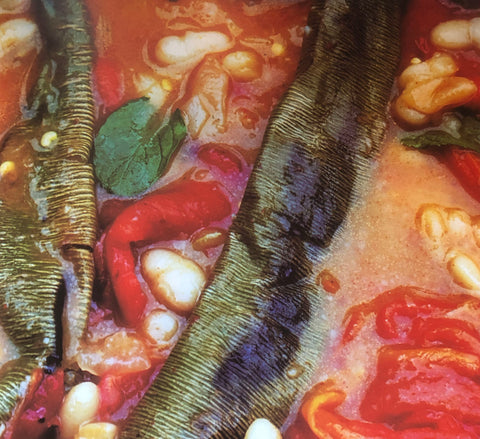Mike's Beaver Fever Sauce
This delectable sauce embodies the sweet, complex aromatic flavors of Beaver Dam peppers with mild heat. Even farmer Erica who can't handle much heat loves it. If you don't like hot peppers, make it with sweet peppers! Great topping almost any dish - we can't get enough of it! We like to freeze it to enjoy all winter long.
Beaver Dam peppers (or sweet peppers if you don't like the heat)
Salt
Olive Oil
Garlic
Cut and roast peppers (400°) in the oven until browned about 30 minutes. Combine ingredients in a blender or food processor. Enjoy!
-- Recipe by Mike Levine
Ajvar

Pictured: Ajvar lathered on fresh homemade bread (Source: Macedonian Traditional Cookbook, by Adriyana Alachki, 2nd Edition, 2012, pg. 92-93)
For 23 jars of Ajvar:
60 kilograms of red ajvar peppers
10 kilograms of eggplants
3.5 liters of oil
100 grams of sugar
salt to taste
1. Wash the jars well and let them drain while you prepare the Ajvar. Wash the peppers; wipe them out with a clean kitchen towel and roast them.
2. After you have roasted the peppers, leave them to cool so that the peeling process goes smoothly. After a few hours, the peppers are ready for peeling. Peel them and remove the stems and seeds. Drain every drop of liquid out of them.
3. Wash the eggplants, wipe them well, and roast them. Same as with the roasted ajvar peppers, roast them, then peel them, then drain the liquid from them.
4. Grind both the peppers and the eggplants with a meat grinder.
5. Pour two liters of cooking oil into a deep bowl, heat it, then add the red peppers and eggplants. Stir and fry at a moderate temperature for several hours. Do not stop stirring or the mixture will be burnt.
6. After the mixture starts changing its color and starts to thicken, gradually add the rest of the cooking oil and the sugar. Towards the end of this stage, add salt to taste.
7. Use the following test to see whether the Ajvar is done: Use a wooden spoon and slide it thorugh the middle of the pan. If the mixture is well separated and not too runny, then the Ajvar is done. Another test is to scoop some of the Ajvar with a wooden spoon, raise the spoon, and flip it over. If the mixture falls down instantly, the Ajvar is not done. The mixture should stick on the spoon.
8. Once the Ajvar is done, remove the pot from the hotplate and start filling the jars which have been preheated in the oven. You need both hot Ajvar and hot jars. Seal the jars well and place them into the jars. Leave the Ajvar-filled jars to cool on their own so that a vacuum can be created and the lids literally stick to the jars. Well-sealed jars is essential to guarantee high quality, well-preserved, food-safe Ajvar.
9. Serve with fresh, homemade bread as a spread. The jars should be kept in a dry and cool place. Refrigerate after opening, and use within one week.
-- Recipe from Macedonian Traditional Cookbook, by Adriyana Alachki, 2nd Edition, 2012, pg. 92-93
Beans with Dried Peppers

Pictured: Beans with Dried Peppers (Source: Macedonian Traditional Cookbook, by Adriyana Alachki, 2nd Edition, 2012, pg. 278-279)
700 grams white kidney beans
5-6 dried Macedonian Embroidered peppers
4 bulbs of onion (finely chopped)
4 cloves of garlic (to taste - finely chopped)
2 tablespoons paprika
oil
1 tablespoon of 'sharena sol' (a mixture of salt, paprika, and other spices)
1 tablespoon mixed dry vegetables
fresh mint to taste
salt to taste
1. Wash the beans, pitting them carefully, and cover them with cold water in a pot on the stove. Boil the beans. Dispose of this water, draining the beans again, and again, pour water into the pot covering the beans. Continue boiling the beans at a low temperature with a drop of oil. Make sure that the beans do not overboil causing the peel to separate from the seed.
2. Once the beans boil and the liquid thickens, drain them and put the beans in a deeper baking pot. Do not dispose of the water from the beans as it may become useful later in this recipe.
3. Sauté the onion in a pan with pre-heated oil until it softens and takes on a golden brown color. Add the garlic and paprika towards the end of the sautéing and remove the pan from the hotplate. Pour it over the beans and mix. Add some of the drained bean liquid (enough to cover the beans).
4. Salt to taste and add the mixed dried vegetables, 'sharena sol' and the mint.
5. Finally, add the dried peppers complete with their stems. Put the pan in a preheated oven at 482F. Once it starts to simmer, reduce the temperature to 347F and continue baking for another 15 minutes. The beans are done once bubbles appear on the surface of the pan, and the peppers become slightly roasted.
6. Take it out of the oven and serve it hot with a salad or dip to taste. Enjoy!
-- Recipe from Macedonian Traditional Cookbook, by Adriyana Alachki, 2nd Edition, 2012, pg. 278-279
Kidney Bean and Dry Pepper Dip

Pictured: Kidney Bean and Dry Pepper Dip (Source: Macedonian Traditional Cookbook, by Adriyana Alachki, 2nd Edition, 2012, pg. 76-77)
300 grams of white kidney beans
10 dried Macedonian Embroidered peppers
2 cloves garlic
salt to taste
1/2 cup oil
1. Wash the beans well and put them into a pot with boiling water. Sprinkle them with some cooking oil, then cook the beans for a longer period while constantly adding water. Once the beans are soft enough, remove the pot from the hotplate, making sure that the beans remain whole and do not disintegrate. When cooked, drain the water from the beans and save it for later use.
2. Use another pan to boil the dried peppers. When ready, remove the dry red peppers from the pan. Let them sit for a while in order to cool, then peel and seed them.
3. Crush the cloves of garlic in a mortar (stone or wooden), and then add the peeled red peppers. After crushing the peppers, add the beans and continue crushing. If the mixture appears too thick, add some of the bean water that we saved - just a spoonful or two.
4. Heat the cooking oil and then pour it over the "dip." You should hear a sizzling sound. Mix well.
5. Serve as a starter with fresh homemade bread.
-- Recipe from Macedonian Traditional Cookbook, by Adriyana Alachki, 2nd Edition, 2012, pg. 76-77
We need more recipes! Share your recipes here.
